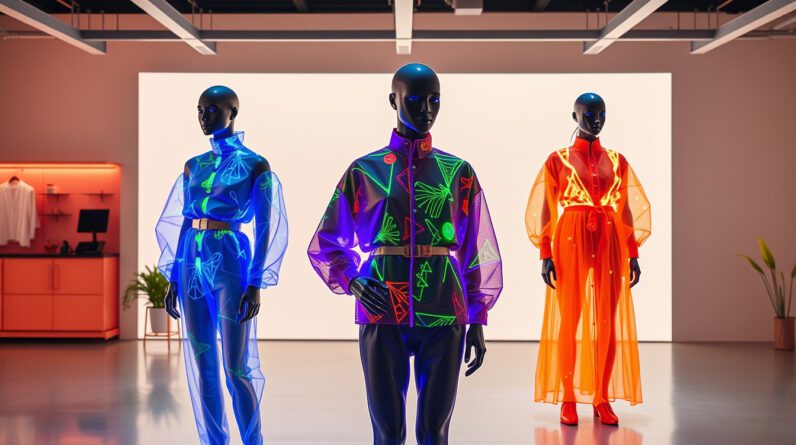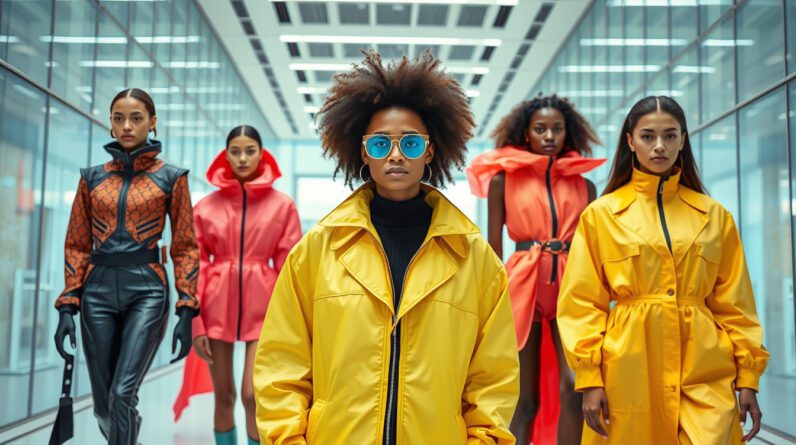
The Role of Fashion in Cultural and Societal Movements
Fashion is a powerful force that can shape and reflect culture. It can be used to express identity, communicate ideas, and challenge social norms. Fashion can also be a tool for political and social activism.
In this essay, I will explore the role of fashion in cultural and societal movements. I will discuss how fashion has been used to express identity, communicate ideas, and challenge social norms. I will also discuss the potential of fashion as a tool for political and social activism.
Fashion is a powerful way to express identity. Clothing can be used to communicate our personality, our values, and our beliefs. For example, a person who wears a suit may be trying to project an image of professionalism and authority. A person who wears a t-shirt with a political slogan may be trying to express their political views.
Fashion can also be used to communicate ideas. Clothing can be used to tell stories, to make political statements, and to challenge social norms. For example, the hippie movement of the 1960s used fashion to express its values of peace, love, and freedom. The punk movement of the 1970s used fashion to challenge the traditional values of society.
Fashion can also be used to challenge social norms. Clothing can be used to subvert expectations, to shock people, and to make a statement. For example, the fashion designer Vivienne Westwood has used her work to challenge traditional ideas about beauty and gender.
Fashion has the potential to be a powerful tool for political and social activism. Clothing can be used to raise awareness for important issues, to mobilize people to action, and to challenge the status quo. For example, the fashion designer Stella McCartney has used her work to raise awareness for environmental issues. The fashion brand Patagonia has used its clothing to raise money for environmental causes.
Fashion is a powerful force that can shape and reflect culture. It can be used to express identity, communicate ideas, and challenge social norms. Fashion can also be a tool for political and social activism.</p
II. The History of Fashion and Culture
Fashion has been a part of human culture for centuries, and it has played an important role in expressing social and cultural values. In the early days of human history, clothing was primarily used for warmth and protection. However, as societies became more complex, fashion began to take on a more symbolic role. Clothing could be used to indicate social status, religious beliefs, or political affiliation.
In the Middle Ages, fashion was highly regulated by social class. The upper classes wore elaborate clothing made from expensive materials, while the lower classes wore simple clothing made from wool or linen. During the Renaissance, fashion became more expressive and individual. Men and women began to wear clothing that was more fitted and stylish.
In the 18th century, the Industrial Revolution brought about a new era of fashion. Mass production made it possible for people to afford more affordable clothing, and new fashion trends emerged rapidly. The 19th century saw the rise of haute couture, or high fashion, which was designed by exclusive designers for the wealthy elite.
In the 20th century, fashion became increasingly democratized. Ready-to-wear clothing became more popular, and fashion trends were disseminated more widely through magazines and newspapers. The 21st century has seen the rise of fast fashion, which is inexpensive clothing that is produced quickly and often changes with the seasons.
Today, fashion is a global phenomenon that is influenced by a variety of factors, including social media, celebrity culture, and economic trends. Fashion is a powerful way to express oneself and to connect with others. It is also a reflection of the times we live in.
III. The Relationship Between Fashion and Culture
Fashion and culture are inextricably linked. Fashion is a reflection of the values, beliefs, and norms of a particular culture. It can also be a way to express individuality and creativity. Culture, in turn, influences fashion by providing the context in which fashion trends emerge and develop.
There are many ways to explore the relationship between fashion and culture. One way is to look at how fashion reflects the values of a particular culture. For example, in Western cultures, fashion is often seen as a way to express individuality and status. In contrast, in some Asian cultures, fashion is more likely to be seen as a way to conform to social norms.
Another way to explore the relationship between fashion and culture is to look at how fashion is used to communicate social messages. For example, in the early 20th century, women’s fashion was used to express the changing role of women in society. In the 1960s, fashion was used to express the counterculture movement.
Finally, we can also explore the relationship between fashion and culture by looking at how fashion is used to create cultural identity. For example, traditional clothing can be used to express a person’s cultural heritage. In recent years, there has been a growing trend towards the use of fashion to create a sense of community and belonging.
IV. How Fashion Reflects Culture
Fashion is a powerful way to express one’s identity and communicate with others. It can also be used to reflect the values and beliefs of a particular culture. For example, the clothing worn by people in a traditional culture may reflect the importance of family, community, and religion. In contrast, the clothing worn by people in a modern, urban culture may reflect the importance of individuality, self-expression, and creativity.
Fashion can also reflect the social and political climate of a particular time period. For example, the clothing worn during the hippie movement of the 1960s reflected the counterculture values of peace, love, and freedom. In contrast, the clothing worn during the conservative era of the 1980s reflected the values of wealth, power, and status.
In short, fashion is a complex and ever-changing phenomenon that is influenced by a variety of factors, including culture, society, and politics. It is a powerful way to express oneself and communicate with others, and it can also be used to reflect the values and beliefs of a particular culture.
How Culture Influences Fashion
Culture is a complex system of beliefs, values, and norms that shape the way people live their lives. It includes everything from language and religion to art and music. Fashion is one of the many ways that culture is expressed, and it can be used to communicate a person’s identity, social status, and values.
There are many ways that culture influences fashion. For example, the climate of a particular region can affect the types of clothing that are worn. In hot climates, people tend to wear lighter, more breathable fabrics, while in cold climates, people tend to wear heavier, more insulating fabrics. Similarly, the religious beliefs of a culture can influence the types of clothing that are considered acceptable. In some cultures, women are required to cover their heads or faces, while in other cultures, people are free to wear whatever they want.
In addition to these more obvious influences, culture can also influence fashion in more subtle ways. For example, the values of a culture can affect the types of materials that are used to make clothing. In cultures that value craftsmanship, people may be more likely to wear clothing that is made from high-quality materials. Conversely, in cultures that value practicality, people may be more likely to wear clothing that is made from durable materials.
Culture can also influence fashion through the way that it is marketed. In some cultures, fashion is seen as a way to express individuality, while in other cultures, it is seen as a way to conform to social norms. The way that fashion is marketed in a particular culture can affect the way that people think about clothing and the way that they choose to dress.
Overall, culture is a complex and multifaceted phenomenon that has a significant impact on fashion. By understanding the different ways that culture influences fashion, we can better understand the role that clothing plays in our lives.
VI. Fashion as a Form of Expression
Fashion is a powerful form of expression that can be used to communicate a variety of messages, including personal identity, social status, and political beliefs.
For example, a person who dresses in a punk style may be expressing their rebellious attitude, while someone who dresses in a business suit may be trying to convey their professionalism.
Fashion can also be used to make a political statement. For example, during the civil rights movement, many people wore black armbands to protest against segregation.
In addition to expressing personal and political messages, fashion can also be used to create a sense of community. For example, members of a particular subculture may dress in a similar way to show that they belong to the same group.
Fashion is a constantly evolving art form that reflects the ever-changing zeitgeist. By understanding the role of fashion in cultural and societal movements, we can gain a deeper understanding of the world around us.
VII. Fashion as a Social Signal
Fashion is a powerful social signal that can be used to communicate a person’s identity, status, and values. The clothes we wear send a message to the world about who we are and what we represent. For example, a person who wears a suit and tie is likely sending a message that they are professional and successful. A person who wears a t-shirt and jeans is likely sending a message that they are casual and laid-back.
Fashion can also be used to express political or social beliefs. For example, a person who wears a Che Guevara t-shirt is likely expressing their support for communism or revolutionary politics. A person who wears a pink pussy hat is likely expressing their support for women’s rights.
The way we dress is a reflection of our culture and society. The clothes we wear are influenced by the values and norms of the society in which we live. For example, in a conservative society, people are more likely to dress modestly. In a more liberal society, people are more likely to dress in a way that expresses their individuality.
Fashion is a powerful tool that can be used to communicate our identity, status, and values. It can also be used to express political or social beliefs. The way we dress is a reflection of our culture and society.
Fashion as a Cultural Marker
Fashion can be a powerful tool for expressing cultural identity and values. In some cultures, traditional dress is an important way to show respect for one’s elders and ancestors. In other cultures, fashion is used to communicate social status or political affiliation. For example, in the United States, wearing a suit and tie is often seen as a sign of professionalism, while wearing a t-shirt and jeans is more casual.
Fashion can also be used to challenge cultural norms. In the 1960s, the hippie movement used fashion to express their rejection of traditional values. In the 1990s, the grunge movement used fashion to express their rebellion against mainstream culture.
Fashion is a constantly evolving art form that reflects the ever-changing values of society. By understanding the role of fashion in cultural movements, we can gain a deeper understanding of the society in which we live.
IX. The Future of Fashion and Culture
The future of fashion and culture is a complex and ever-changing landscape. However, there are a few key trends that are emerging that are likely to have a significant impact on the way we dress and the way we interact with the world around us.
One of the most important trends is the growing emphasis on sustainability. Consumers are increasingly demanding that brands adopt more ethical and sustainable practices, and this is having a ripple effect on the fashion industry. Brands are now looking for ways to reduce their environmental impact, and they are also starting to use more recycled and sustainable materials in their designs.
Another key trend is the rise of personalisation. Consumers are no longer satisfied with mass-produced clothing that is the same as everyone else’s. They want clothing that is unique and reflects their own personal style. This is leading to a growing demand for bespoke and custom-made clothing, as well as the increased use of technology to create personalised clothing experiences.
Finally, the future of fashion is likely to be increasingly digital. As more and more people shop online, brands are starting to focus on creating immersive and engaging digital experiences for their customers. This includes using augmented reality and virtual reality to allow customers to try on clothes before they buy them, as well as creating online communities where customers can share their fashion tips and inspiration.
The future of fashion and culture is an exciting one, and it is sure to continue to evolve in new and unexpected ways. By understanding the key trends that are emerging, brands can stay ahead of the curve and create products that meet the needs of today’s consumers.





